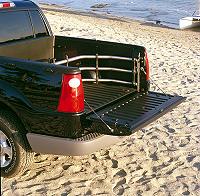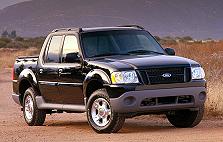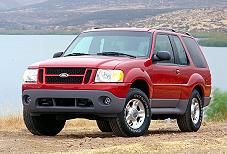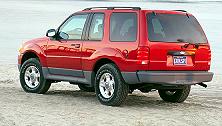ALL-NEW 2001 FORD EXPLORER SPORT TRAC
OFFERS MORE VERSATILITY FROM BEST-SELLING SUV LINEUP
PHILADELPHIA, Aug. 16, 1999 The
2001 Ford Explorer Sport Trac the newest member of Fords best-selling
Explorer family represents an important revolutionary step in the fast-growing
sport utility vehicle (SUV) segment by creating significantly more room
for cargo than the traditional SUV without compromising the interior package
SUV customers want.
 Explorer
Sport Trac combines the benefits of the four-door Explorer with the added
utility of a 4-foot-long cargo area made of durable sheet molding composite
a first in the segment for one-vehicle-does-it-all versatility.
The cargo area features, which include an optional device that extends
the length of the cargo area and an optional lockable hard tonneau cover,
allow it to be converted easily to accommodate a wide variety of cargo. Explorer
Sport Trac combines the benefits of the four-door Explorer with the added
utility of a 4-foot-long cargo area made of durable sheet molding composite
a first in the segment for one-vehicle-does-it-all versatility.
The cargo area features, which include an optional device that extends
the length of the cargo area and an optional lockable hard tonneau cover,
allow it to be converted easily to accommodate a wide variety of cargo.
In dealer showrooms early next year, Explorer
Sport Trac is expected to be the first vehicle of its kind offered for
retail sale.
Explorer Sport Trac is great for the active
customer, says Jim OConnor, Ford Motor Company vice president and president,
Ford Division. This rugged vehicle is certain to appeal to outdoor
sports enthusiasts, do-it-yourselfers and adventure seekers.

Theres a demand for a vehicle like this,
and we intend to lead the industry by responding to the market needs with
more and more of what customers want sooner and certainly before anyone
else.
Ford was the first manufacturer to experiment
with such a vehicle when, in January 1996, it introduced the Adrenalin
concept vehicle at the Los Angeles Auto Show. Adrenalin was a design
exercise intended to gauge consumer reaction to a versatile and rugged,
off-road, four-wheel-drive vehicle.
Adrenalin featured a unique mix of toughness,
refinement and comfort in a vehicle that was comfortable at work and play.
Positive public response to Adrenalin led directly to Explorer Sport Tracs
development.
Rugged Versatility Outside and In
Based on the Explorer platform, Explorer
Sport Tracs rugged, athletic styling takes on a look all its own.
From the C-pillar forward, Explorer Sport
Trac is a five-passenger SUV. But, behind the rear passenger
compartment, Explorer Sport Trac breaks the mold, featuring one of the
industrys first one-piece, all composite cargo areas. Made of durable
sheet molding composite (SMC), it has molded-in texture, a mar-resistant
low-gloss coating, and is virtually maintenance-free, requiring no liner.
The easy-to-care-for cargo area handles clean or dirty cargo.
An optional two-piece foldable and lockable
hard tonneau cover provides protection for items contained in the cargo
area. It comes with a removable divider, also made of SMC, that increases
storage flexibility for the cargo area. The tonneau cover can be
removed easily, allowing customers to convert the cargo area from covered
and locked to a uncovered and open for carrying large bulky, items.
Cargo area utility is further enhanced
by 10 cargo tie downs six located along the top rails and four on the
inner panels and a 12-volt cargo area power point.
An optional cargo keeper also extends the
utility of the cargo area. This U-shaped tubular device hinges on the interior
sides of the cargo area and rests on the cargo floor. When flipped
out over Explorer Sport Tracs tailgate, it extends the cargo area length
from more than 4 feet to almost 6 feet to accommodate several 4- by 8-foot
sheets of plywood or other materials. In its stowed position, the
cargo keeper creates a contained, 25- by 45-inch storage area, which is
ideal for holding grocery bags or other small items in place.
Explorer Sport Tracs interior also achieves
new levels of versatility, featuring the segments first washable, textured
rubber flooring. This tough, high-quality material covered by removable
Berber carpet floor mats offers utility, easy care and enhanced sound
insulation. Additionally, both leather and cloth seating surfaces
are easy to clean.
A standard power down/up rear window feature
enables the rear window of the Explorer Sport Trac to be raised and lowered
by a control knob on the instrument panel. Tapping the knob lowers
the rear window by 1.5 inches to the vent position. An express up/down
feature with safety stall allows the window to be lowered or raised completely
by briefly twisting the knob clockwise or counterclockwise.
Engineered for Functionality
Explorer Sport Trac, in 4x2 and optional
4x4 configurations, delivers a unique combination of smooth on-road ride
and impressive off-road capability.
Explorer Sport Trac shares its basic front
and rear suspension geometry with todays four-door Ford Explorer.
However, its bushings, spring rates, shock valving and stabilizer bars
have been modified for improved ride, handling and noise/vibration/harshness
performance over todays four-door Explorer.
Explorer Sport Tracs independent front
suspension has a single lower control area, gas shock absorbers, torsion
bar springs and a front stabilizer bar. The rear suspension includes
gas-pressured shocks and two-stage variable-rate leaf springs for a more
carlike ride. Bushings and isolators have been tuned for optimal
ride performance and are designed to keep the vehicle level under loaded
conditions.
Power rack-and-pinion steering is standard.
All Explorer Sport Trac models are equipped
with Fords proven 4.0-liter V-6 engine, Explorers most popular powerplant.
This single overhead cam engine, which produces 206 horsepower at
5,000 rpm and 238 lbs.-ft. of torque at 4,000 rpm, is linked to an electronically
controlled five-speed automatic transmission.
All Explorer Sport Trac models come with
a standard four-wheel anti-lock braking system. The system controls
the front wheels independently and the rear wheels in tandem to improve
vehicle control under heavy braking in most operating conditions.
The system includes dynamic rear proportioning to help optimize stopping
performance under varying vehicle load conditions.
Explorer Sport Trac has Class II trailer
towing capacity towing up to 5,300 pounds.
New Niche in the SUV Market
Since 1981, sport utility vehicle sales
have grown from fewer than 200,000 units to nearly 2.8 million units annually
in the United States.
Ford Explorer is the sales leader.
Introduced as a 1991 model, Explorer was the best-selling SUV in the United
States for the eighth consecutive year in 1998 with sales of 425,000.
It outsold its nearest competitor by nearly 2-to-1.
Explorer Sport Trac is expected to reinforce
Explorers sales leadership position and is targeted to fill a new niche
for customers wanting one vehicle that does it all from carrying a family
to hauling supplies. The vehicle is expected to attract buyers considering
SUVs, sports coupes and compact pickup trucks.
2001 FORD EXPLORER SPORT MAKES DEBUT
WITH NEW STYLING, FEATURES

PHILADELPHIA, Aug. 16, 1999 The
Ford Explorer Sport sales leader among two-door sport utility vehicles
is even better for the 2001 model year with new sporty styling, features
and functional improvements designed to inspire confidence in any driving
situation. The new model was unveiled today during a preview to Ford
dealers.
On sale beginning early next year, the
2001 Explorer Sport aims to strengthen its leadership position with significant
changes to exterior sheet metal, a new interior, more front leg room
and improved ride and handling characteristics.
Sales of the two-door Explorer have increased
each year from 31,700 units in calendar year 1991 to nearly 112,000 units
in calendar year 1998.
Sporty Styling
As its name implies, the Explorer Sport
is the sportiest member of the Explorer family, catering to customers who
are young, active and independent-minded looking for more fun and adventure
than he or she can find in a car.

For the 2001 model year, Explorer Sport
shares its new modern front-end sheet metal with the all-new Explorer Sport
Trac, which also goes on sale beginning early next year. Complex-reflector
headlamps flank a signature Ford grille which flows back and up to the
vehicles muscular power dome hood. An upswept, wraparound front
fascia houses driving lamps and integrates with the vehicles lower body-side
molding.
Optional tow hooks integrate into openings
in the lower bumper. Wheel flares are integrated into the sheet metal.
Inside, Explorer Sport receives additional
sporty touches, including new interior trim and a distinctive white dial
instrument cluster.
New Features, Improved Package
The 2001 Explorer Sport is designed with
several new features.
The standard floor console includes two
larger and improved front cup holders, an open front storage area convenience
clip, twin retractable rear cup holders and a removable soft pack storage
bag for holding CDs and other items.
The optional console adds a coin holder,
front power point, flow-through ventilation with rear blower controls and
rear-mounted audio headphone jack/audio controls.
The optional power moon roof can be tilted
open or fully retracted into the roof. It includes a second, manually retractable
sliding sun shade. An express one-touch open feature fully retracts the
moon roof when the control switch is pressed briefly.
A front overhead console is optional. It
houses two map/courtesy lamps, compass, outside temperature display and
garage door opener storage bin or, for models equipped with a moon roof,
the moon roof switch.
Customers can choose from two audio systems.
The standard 60-watt system uses four premium speakers and includes AM/FM
stereo radio, clock and single CD player. An optional, 290-watt audiophile
quality system features a six-disc in-dash CD player and seven speakers
(two coaxial tweeter/midrange speaker sets in the front doors, two single
rear door speakers, plus subwoofer).
Designed to seat four adults comfortably,
Explorer Sports passenger compartment offers customers best-in-class roominess
and increased front leg-room compared with the previous model. With
nearly 70 cubic feet of maximum cargo space and the ability to tow up to
5,180 pounds, Explorer Sport is perfect for active lifestyles.
Confident
The new Explorer Sport is powered by Fords
4.0L SOHC V-6, which produces 206 horsepower at 5,000 rpm and 238 lbs.-ft.
of torque at 4,000 rpm. The engine is linked to a five-speed electronically
controlled automatic transmission.
The new Explorer Sport offers drivers a
command seating position for a better view of the road and comes in 4x2
and optional 4x4 configurations.
Ford engineers took several steps to improve
the ride and reduce cabin noise in the 2001 Explorer Sport over todays
model, and a stiffer frame improves vehicle dynamics and contributes to
lower noise, vibration and harshness. A sound dampening floor system
helps block noise from entering the passenger compartment. Also,
the instrument panel and laminated dash sheet metal are designed to reduce
the transfer of engine noise to the passenger compartment.
Suspension improvements contribute to a
better ride. Front and rear stabilizer bars are standard, and the
modified front caster improves drift/pull characteristics. Also,
revised shock tuning and a new multistage rear leaf spring suspension reduce
ride harshness.
All models come with standard power rack-and-pinion
steering for precise, carlike steering characteristics.
The Explorer Sport is fitted with a larger,
more durable and quieter four-wheel disc braking system, which achieves
a shorter stopping distance. Front brakes have larger rotors, phenolic
pistons and stiffer calipers. All models have new front-wheel dust
shields to assist in rotor cooling.
A four-wheel, three-channel anti-lock braking
system is standard. This system controls front wheel braking independently
and the rear wheels in tandem during an emergency stop. Dynamic rear
proportioning optimizes non-ABS stopping performance under varying load
conditions.
Reprinted with permission
|

